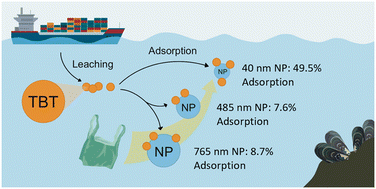Sub-100 nm nanoplastics: potent carriers of tributyltin in marine water†
Abstract
Despite laws prohibiting its usage, butyltin (TBT) is a legacy pollutant and an antifouling agent that is still prevalent in marine systems and has been shown to have negative effects on the ecosystem. The purpose of this study is to fill a vacuum in the literature by determining whether nanoplastics (NPs, <1000 nm) can carry TBT, which might provide a new TBT exposure pathway to marine organisms. Adsorption capacity was modelled using nanopolystyrene (PS-NP) with three particle sizes spanning the nano-range (40, 485 and 765 nm). Kinetics and thermodynamics of TBT adsorption by PS-NP were explored within natural sea water (32 psu), brackish water (16 psu), artificial sea water (32 psu), and a sodium monophosphate/diphosphate buffer (pH 8, 0.1 M). Elemental analysis, following adsorption experiments, was completed by inductively coupled plasma-mass spectrometry and microwave plasma-atomic emission spectroscopy. Between 78 and 99% of the total TBT adsorption occurred within the first 0–6 hours of mixing. Freundlich isotherm models provided the most accurate fit to experimental data for each water and polystyrene particle matrix (R2 values between 0.9086 and 0.9970), suggesting that the system underwent non-ideal or multilayer adsorption. The greatest capacity for adsorption was observed with the smallest plastic particles (49.5–85.6% (m/m)) and within the brackish water matrix (40.0–85.6% (m/m)). This suggests that the adsorption capacity increases with decreasing particle size and salinity, highlighting that nanoplastics have greater potential to act as a vector for the transportation of TBT over microplastics, and that adsorption is restricted by the presence of competitive salts. Distribution coefficients (KD) for TBT adsorption by PS-NP (between 193 ± 9 L g−1 and 2853 ± 291 L g−1) are consistent with the upper range of literature reported values for sediment adsorption. This suggests that PS-NPs have similar potential for TBT adsorption to naturally occurring sediment particles. When considering the differences in specific gravity between NP and sediment particles, this research highlights a concern of increased TBT mobility when bound to NPs, and the potential for TBT to become more available to surface-dwelling organisms such as those residing in tidal zones.

- This article is part of the themed collections: Recent Open Access Articles and Environmental fate of nanomaterials


 Please wait while we load your content...
Please wait while we load your content...